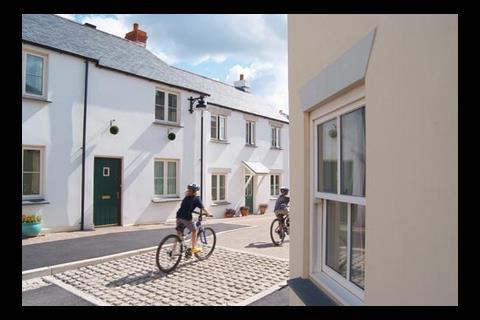Government policy has promoted the village as the sustainable way of living, but that has dramatically changed the way housebuilders develop, as Josephine Smit finds out
The village, St Austell
Midas galliford try

Project
Its traditional architecture gives the impression that The Village has been part of St Austell for centuries, but the crispness of the render gives the game away. This is a newly completed development and perhaps an unlikely looking regeneration trailblazer for a town that is going through significant change.
The 148-home The Village was developed over a four-year build programme on a steeply sloping former railway yard site on the edge of town. The site was masterplanned by David Lock Associates as a sustainable urban village with a mix of homes and other amenities. The 148 homes include 22 affordable units and six live/work units. The site also contains a 25,000ft2 office building, 12,000ft2 of start-up office space and 3,500ft2 of retail space including a pharmacy and convenience grocery store.
The housing element of the scheme includes 25% affordable housing, pepperpotted across the site in small groups of three or four units. Office space is located to the rear of the housing site. The start-up office space is in an enterprise centre which sits at the heart of the scheme and has a contrasting contemporary design. Other improvements to the site include a village green and the restoration of a once-polluted culvert.
The scheme was brought forward by Devon and Cornwall Housing Association and Restormel council. They worked with the Prince’s Foundation to bring on board a developer via competitive tender. Galliford Try’s South Western housebuilding brand Midas Homes won the tender to build under a licence agreement. They are working with architect Alan Leather Associates. Housing association partners are Devon and Cornwall HA and Penwith HA.
The brief
Housing in The Village reflects every type of English vernacular from candy-pink Cornish cottage to formal terrace. The narrow village-lane style streets and architecture echo that model of village vernacular, Poundbury, and clearly show the influence of the Prince’s Foundation. David Wood, director with Galliford Try confirms that the foundation had a strong input into the design: “We looked at everything early on with the Prince’s Foundation. There was a lot of consultation – nine to 12 months.”
Feedback
With contiguous streetscenes and some 20 housetypes, the scheme was never going to be easy to construct, and the sloping site exacerbated the complexities of building the masonry homes. “We have different housetypes on a curve and stepping down a site. There were technical challenges in that it was difficult to E E build,” says Jerry Dawkins, site project manager with Midas. As a West Country-based business, Midas was able to use its local knowledge to advantage in sourcing local subcontractors. “If we had been new to the area we would have struggled to have got the quality of workmanship,” Wood adds.
You have to accept that just because you have been housebuilding for a while, you don’t necessarily know it all
David Wood
Both construction and the design and development process have taken the developer through a learning curve, as Wood explains: “We had to come up with the concept of an urban village for a medium-sized town. We wanted something that would be an exemplar. This scheme was a first for Midas, and was about where we wanted to go as a company. This turned us into an urban regeneration company.
“From this project we learned that we had to put the time and effort in to get the conceptual stuff right. We used to say: we need 20 houses on that site. We started at The Village not with a set of housetypes but with a blank sheet of paper. We do that all the time now. We ask what more we can get out of a site.”
Midas not only had to take a different approach to the end product on this project; it also found it could no longer play the role of solo developer. “We learned about partnering with the local authority and other agencies, and we broadened the scope of our knowledge. We used the learning of the team approach of this project,” says Wood.
Happily, the project produced a useful lesson about profit, which may explain why Midas has since grown its regeneration activity significantly, with schemes such as Millbay in Plymouth. Wood says: “The scheme’s profitability exceeded expectations and that benefited all partners in overage. We all had a joint interest in maximising property values.”
At the end of last year, a two-bedroom home sold for £160,000, and a four-bedroom house for £249,950, 19% up on sales prices at the scheme’s start four years ago.
The scheme sold through both a downturn and an upturn and there was a good steady rate of sale for everything from first-time buyer homes to aspirational detached houses. Only one aspect of the mix proved too audacious for the St Austell market: the live-work housing did not sell as work, but it did sell purely as living accommodation.
Sherfield park, Basingstoke
Croudace homes

Project
Sherfield Park, near Basingstoke was going through its first detail design stages in 2000 just as that seminal piece of housing planning guidance PPG3 emerged, and so marked the evolution of the housing estate into the community. With 1,000 homes this is definitely a housing estate writ large, but it bears some characteristics of community-building, with its emphasis on site-specific architecture rather than standard housetypes and its inclusion of a neighbourhood facility including a village hall and commercial premises. And, in a leafy area where private buyers and affordable housing tenants are seldom next-door neighbours, the scheme is notable for mixing tenure, with affordable homes being pepperpotted.
Construction of the scheme began six years ago with 39 homes for market sale. The ensuing four phases of development have provided 226 private homes, 33 social rented units and 42 shared ownership homes. Croudace is working with housing associations Sovereign and Kingfisher on the project, and design of the scheme is by PRP. The site was masterplanned by Floyd Matcham with Charles Planning Associates as planning consultant. Strategic infrastructure was by consulting engineer Stuart Michael Associates. Build out of the site is expected to take seven more years.
Pepperpotting can be sensitive. It requires careful management
Russell Denness
Brief
Back at the turn of the millennium the arrival of PPG3 was causing some consternation among housebuilders. Croudace managing director Russell Denness recalls the origins of the design: “We thought PPG3 didn’t give much to the end customer, except design, so we decided to go out to PRP for the design of the first two phases and ask them to come up with something a bit different to standard housetypes. We wanted either a strong contemporary style or traditional. Contemporary was unsure ground as far as customer perception was concerned at that time, so we went for tried and trusted traditional.”
Croudace trialled pepperpotting on a scheme in Newbury, Berkshire and promoted its application at Sherfield Park. Denness says of the Newbury trial: “The rationale was that if we were going to do 30% social housing, we’d rather not put it all together and stigmatise it, but would prefer to disperse it. It was successful enough at Newbury for us to want to try it again.” The scheme is not only tenure-blind, but also puts top priced six-bedroom detached houses alongside small starter homes. The layout arranges the diverse homes in neighbourly clusters, with car parking grouped into courts accompanied by the now ubiquitous FOGS or flats over garages.
Feedback
Private and affordable housing is indistinguishable externally, although there are some minor differences internally. Some buyers are resistant to pepperpotting but Croudace sales director Janni Phipps says the company works at dealing with prejudice: “We sell pepperpotting in a positive way and find that as long as we are upfront about it, people are positive. We challenge people by taking them for a tour of the site and asking them to spot which homes are in which tenure.” Denness picks up the theme: “We sold a house for more than £500,000 that was next door to a three-bedroom rented unit.” Denness points out that the success of pepperpotting depends on working with housing association partners to ensure that the scheme is well managed. Having discovered pepperpotting works, the housebuilder is now applying it at many sites, including key large-scale schemes in Daventry and Stansted.
Initially however, sales of homes proved slow. “It was a bit sobering because we had put a lot of money into the scheme,” recalls Denness. “But the problem was people couldn’t see the concept. Once we had the first square finished it started to sell and it has sold well ever since.”
The site’s 13-year build programme is running through a period of significant change in government policy. “Every year there is another set of regulations,” Denness says wearily. Having embraced the challenge of social mix, the company is now taking on the Code for Sustainable Homes, by building five homes containing environmental technology. Kingfisher Housing Association will rent out three of the homes, and Croudace will rent out the remainder to allow it to monitor how the environmental technology performs in use.
The housebuilder has changed its stance through the scheme. Having stipulated traditional design at the start, Croudace is now looking at a contemporary design for a future phase. Denness explains: “It has been difficult to evolve it naturally. We’re doing it by still using traditional materials. We think that now contemporary design has gained more market acceptance, and when you are building 1,000 homes, you have to introduce variety.” Croudace also hopes to give the village a modern village hall.
But the biggest change has come within Croudace itself, as a result of working with PPG3, as Denness says. “It fundamentally changed our approach to design. It replaced standard housetypes with new designs, and also introduced a new range of details. We now have more architects working for us than engineers, when levels used to be the same.”
But one thing appears never to change in housebuilding: planning obstacles. Croudace has not found the going easy, notably arguing unsuccessfully for three years to try to give the scheme more stylish light columns than the ones Hampshire council’s highways department wanted. “We’ve had a very good working relationship with the planning officers day to day,” says Denness. “Where it has been difficult is with the politicians.”
Source
RegenerateLive




























No comments yet